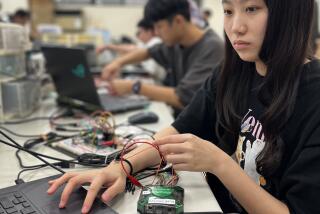U.S. Computer Chip Venture Faces Setback
- Share via
ANDOVER, Mass. — Three months ago, the government-backed Sematech chip-research consortium celebrated a milestone: it had produced leading-edge computer chips using only American-made equipment.
Now that achievement is in danger of being overshadowed by an embarrassing failure, one that would present the Clinton Administration with an early and unwelcome lesson in the hazards of an activist high-tech policy. The producer of the most important equipment used in Sematech’s landmark demonstration, a Massachusetts company called GCA Corp., is on the block--and on the brink of going out of business.
GCA is believed to have received more than $60 million in Sematech funding over the last five years as part of the consortium’s effort to restore U.S. competence in computer chip manufacturing. But even though the money has enabled GCA to re-establish itself as a technology leader in the arcane but critical field known as photolithography, the company has been unable to crack a market dominated by Nikon and Canon of Japan.
GCA’s parent, General Signal Corp., weary of losses at the subsidiary, has put GCA up for sale, and buyers have expressed interest only in two small pieces of the company. Workers at the GCA factory here--only 170 remain from a force that once reached 434--received 60-day dismissal notices last month. Operations have virtually ceased, and even GCA President Robert Carey seems resigned to a final shutdown.
Government and industry officials say the failure of GCA would be a major setback for Sematech and U.S. technology policy. Chip-making equipment is the first link in a high-tech food chain extending from raw silicon to advanced computer applications, and many thus consider it essential to U.S. competitiveness.
The demise of GCA would underscore the contradictions in federal efforts to finance commercial research and development without getting involved in business decisions, and undermine the chip industry’s claim that it is willing to do its part to protect critical technologies.
The Administration has promised to expand the government’s role in high-tech development, and has often cited Sematech as a model. Administration officials are now scrambling to arrange a last-minute rescue of GCA. Sources say American Telephone & Telegraph, Motorola and other companies are being urged to take part in an industry-led buyout of GCA, but the effort appears to face long odds.
“It’s very frustrating to have people tell you that you’re the best company in the business but that you’re going to go out of business,” laments Carey. “There is a tremendous capability here that will be lost at the stroke of a pen. Once the doors close, you have nothing.”
The immediate cause of GCA’s crisis is simple enough. The company builds a complex piece of photolithography equipment known as a “wafer stepper,” a kind of camera used to print circuit patterns onto raw silicon chips, and it has been unable to sell more than a handful of these machines during the last several years.
But the company’s predicament--and the dilemma it poses for U.S. technology policy--has been many years in the making. Founded in 1958 by a group of Air Force scientists who dreamed of creating the next RCA--GCA stands for Geophysical Corp. of America--GCA built the first wafer stepper in the 1970s and zoomed to prominence during the go-go years of the U.S. semiconductor industry in the late 1970s and early 1980s.
Annual revenue soared past $300 million by 1984. GCA virtually owned the business worldwide, and profits poured in as both U.S. and Japanese chip companies filled factories with GCA equipment.
But in 1985, the bottom fell out as GCA’s revenue fell by half. Success had bred arrogance, and quality control went out the window. Enormously expensive chip production lines were idled as GCA equipment malfunctioned, earning the company the deep animosity of many plant managers. At the same time, semiconductor sales slumped and U.S. firms suddenly were overwhelmed by Japanese rivals, who in turn were eager to work with their own suppliers, notably Canon and Nikon.
By the time the company was purchased by General Signal in 1988, it was a basket case. But that year marked the start of operations for Sematech, a consortium that gets $100 million a year from the government and an equal amount from computer chip makers.
Sematech’s mission was to restore American manufacturing competence in computer chips, and it soon evolved into a support organization for troubled chip-equipment companies, such as GCA.
Neither Sematech nor GCA will disclose how much money the company has received from the consortium over the last five years. But Dan Hutcheson, president of the market research firm VLSI Research, estimates GCA has received $60 million to $80 million from Sematech. Sematech’s own disclosures and many government and industry sources seem to confirm Hutcheson’s estimate.
Sematech’s support of GCA was a technical success. Quality is sharply better and the company’s newest machine is considered by many to be superior to anything Nikon and Canon can offer. Carey offers many testimonials from customers attesting to a remarkable turnaround, and the GCA stepper was central to Sematech’s January demonstration of its ability to produce chips with circuits only a microscopic 0.35 microns wide.
Yet commercial success has not followed, in part because of the cyclical nature of chip-equipment purchases and the long lead times required. Technical glitches in 1990 caused GCA to be passed over for contracts that would be yielding significant orders today, and GCA does not stand to gain major sales for its current machine for at least two more years.
Meanwhile, GCA is caught in a Catch-22: Chip companies do not want to buy from a vendor that may not be around in a few years, and, by not buying, they virtually assure that GCA will not be.
GCA is also still suffering the fallout from 1985. Says VLSI’s Hutcheson: “There are a lot of people who won’t buy from GCA because they got burned 10 years ago, when GCA was shipping junk.”
The reluctance of chip companies to buy from GCA calls into question Sematech’s decision to spend so much on it. William Spencer, Sematech’s chief executive, acknowledges that the collapse of GCA would be a major failure for the consortium, but says Sematech will inevitably end up making some bad bets.
“We’ve had a high success rate,” he said, adding: “We never tried to assure that companies will be a business success. Sematech’s focus is manufacturing technology, not business.”
Spencer points out that there is still one other American company in the photolithography business, a firm called SVG Lithography, whose equipment was also used in the January demonstration. But SVG has bet on a promising but expensive new technology that is not fully proven, and is itself on shaky financial ground.
Indeed, government and industry officials are in broad agreement that the loss of GCA would be a significant blow to American self-sufficiency in computer chip making. U.S. chip companies would be almost entirely reliant on Canon, Nikon and a Dutch company called ASM for a critical piece of gear.
Yet it is not at all clear how to rescue GCA. Chip companies have not taken the obvious step of giving GCA the benefit of the doubt and buying its equipment. Sematech itself will not get involved in business rescues. Large companies that might have been saviors in the past--notably IBM Corp.--are in no position to assume that role today.
Ironically, a buyout by a foreign company, which would at least save several hundred good jobs, is considered extremely unlikely because of the political fires it would ignite. Foreign bidders once lined up to buy financially struggling American technology companies, but are now reluctant to fight the sometimes-nasty political battles that such acquisitions increasingly provoke.
General Signal chief financial officer Stephen Nagy would not comment on specifics of the sale negotiations but said he hoped the situation would be resolved within a week or two.






